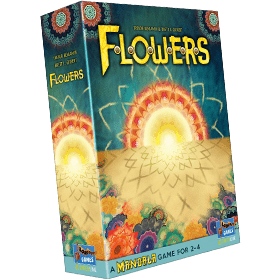Flowers: A Mandala Game
 ใน FLOWERS เป้าหมายของคุณคือการรวบรวมแผ่นดอกไม้โดยบรรลุส่วนใหญ่ผ่านการเล่นไพ่ที่ชาญฉลาด
ใน FLOWERS เป้าหมายของคุณคือการรวบรวมแผ่นดอกไม้โดยบรรลุส่วนใหญ่ผ่านการเล่นไพ่ที่ชาญฉลาด
สร้าง Mandalas อย่างชำนาญเพื่อรับแผ่นกระเบื้องที่ดีที่สุด ผสมผสานและขยายพันธุ์เพื่อสร้างดอกไม้ที่สวยงามของคุณเอง!
จำนวนผู้เล่น: 2 - 4
ระยะเวลาของเกม: 12 mn
ความซับซ้อน: 1 / 5
เล่น Flowers: A Mandala Game และ 1194 เกมอื่นๆ ออนไลน์
ไม่จำเป็นต้องดาวน์โหลด - เล่นได้โดยตรงจากเว็บเบราว์เซอร์ของคุณ
กับเพื่อนและผู้เล่นนับพันจากทั่วโลก
ฟรี.

เล่น Flowers: A Mandala Game และ 1194 เกมอื่นๆ ออนไลน์
ไม่จำเป็นต้องดาวน์โหลด - เล่นได้โดยตรงจากเว็บเบราว์เซอร์ของคุณ
กับเพื่อนและผู้เล่นนับพันจากทั่วโลก
ฟรี.

กฎย่อ
Overview
Play cards to Mandalas to win Flower halves and try to pair them up with flower halves of the same colour
Turn
A turn comprises of 4 stages:
Play
Draw
Check
Complete
Play
Pick any number of cards of a single colour and play them onto a single Mandala orientated towards yourself so it's easy to see who played which cards
If the colour is new to the Mandala, as in it does not match the color of one of the flower tiles and neither you nor anyone else has introduced it to the Mandala yet, play them faceup
If the colour is already present in the Mandala, display them briefly to the players to confirm this, then play them facedown
Draw
If you have 8+ cards, nothing happens
If you played a single card, you can draw up to 4 cards, whilst your hand size may not exceed 8 from this draw
If you played 2+ cards, you cannot draw even if below hand limit
Regardless of what you were allowed to draw or not, you must end this step with 1 card in hand, which means you cannot empty your hand in Play stage if you are disallowed from drawing in Draw stage i.e. if you had 1 card, and played 1 card, you will still draw so this is allowed, if you had 2+ cards and played them all, you cannot draw, so can't Play them all
Check
If all the cards in the Mandala played to on your side are facedown, nothing happens
If you have played the strict majority of cards to this Mandala, with at least 1 faceup card for both you and those you are comparing with, you claim it and put the marker on your cards i.e. if other players only have facedown cards, but have more than you, they still lose the majority
Complete
If the Mandala played to contains 5 or fewer independent colours, nothing happens
If the Mandala played to now contains all 6 colours, remembering to count the two flower tokens as representatives for their colours, a Completion can happen
The player with the Claim Marker, which doesn't have to be the current player, takes a flower token of their choice
The player with the second highest number of cards, with at least 1 faceup card, takes the remaining flower token (if tied for second, the player with the most faceup cards wins it; if the tie persists, the Claim Marker player takes both) The Claim Marker player also takes both if there is no second place player e.g. perhaps all other players only played facedown
(In a 2-player game, you only get a flower tile if you have at least half as many cards (including at least 1 face-up card) in the Mandala as the player with the claim marker. Otherwise, that player takes both flower tiles.)
If anyone now gains the second flower token of the same colour previously obtained, they pair them together and flip them to their completed side
Note: Taking of flowers and pairing of them happens when they are taken, so however they complete, they must stay, you can't switch pairs around later on
If you took a Flower token, all of your cards in the Mandala go into the discard pile
If you did NOT take a Flower token, all of your cards in the Mandala are retured to your hand
Finally, draw a new light and dark flower token to replace the ones claimed on the now empty Mandala
Game End
The game ends when a player creates their third flower pairing or when there are not enough flower tiles to fill an empty Mandala
Regardless of how it ends, the two Mandalas which did not cause end game are Completed as you would in a normal Complete phase, just ensure to fully Complete one before resolving the other, this will create additional opportunities for flower pairing
Any flower tiles that a player failed to pair up are worth the number of flowers depicted on them
If a solitary flower tile has instead a multiplier, i.e. X3, this is worth nothing
For paired flowers, if it shows a multiplier, multiplier the number of flowers on the other half by the multiplier e.g. x3 and 2 would give 6
For paired flowers without a multiplier, double the lower value and add it to the higher one, e.g. 3 and 2 would give 2+2+3 for 7
The player with the highest total points, wins!
If tied, the player with the most remaining hand cards, wins!

